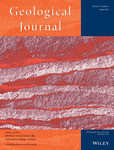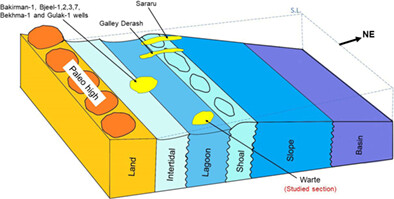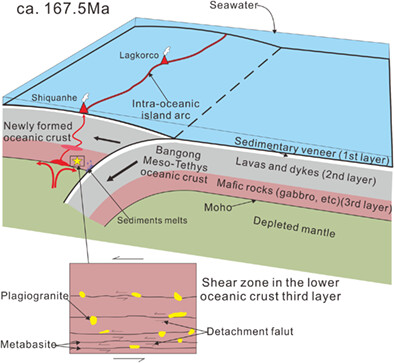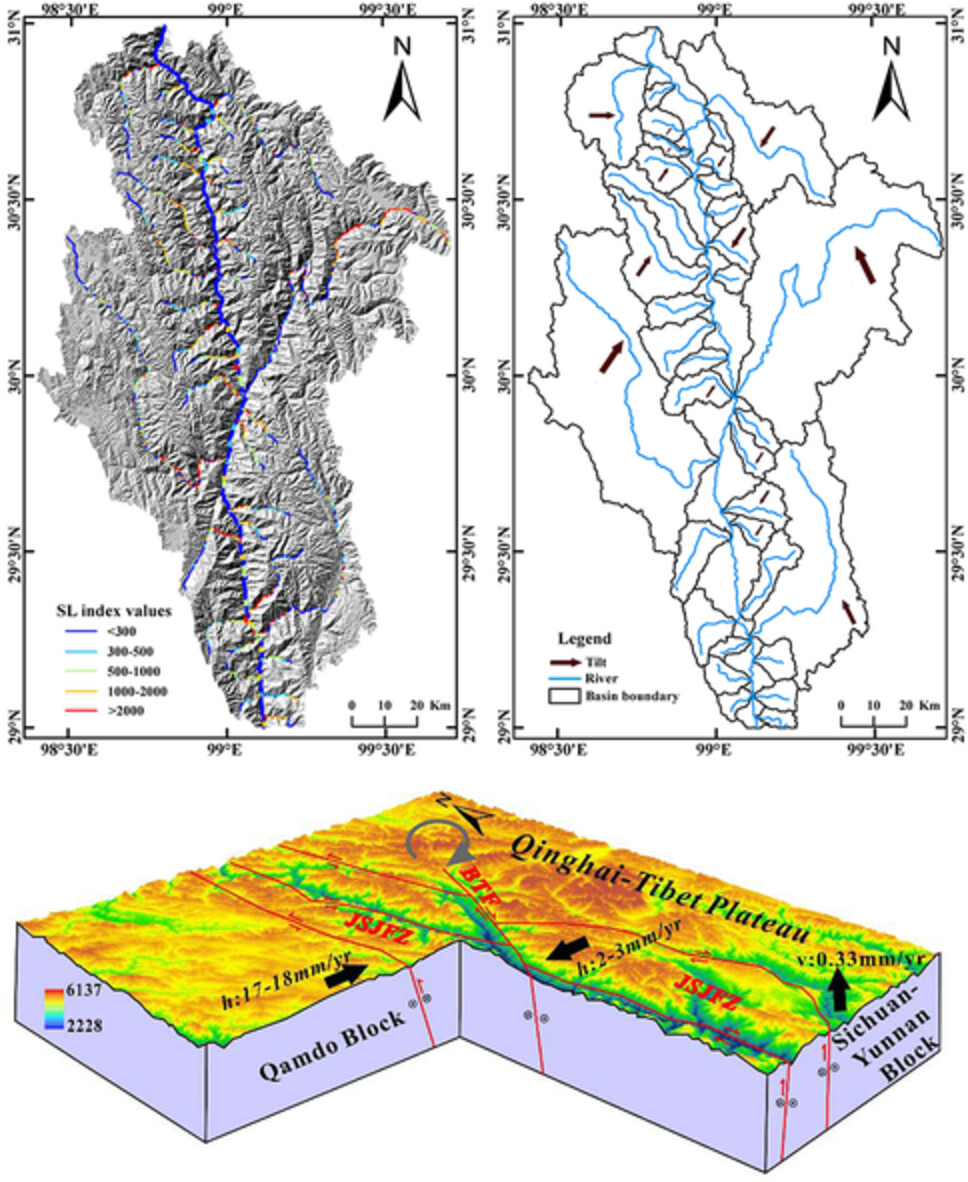Journal list menu
Export Citations
Download PDFs
ISSUE INFORMATION
RESEARCH ARTICLES
Sedimentology of the Baluti Formation (Late Triassic) in the Warte area, northeastern Iraqi Kurdistan region
- Pages: 3923-3940
- First Published: 07 April 2021
An island arc origin of Jurassic plagiogranite in the Shiquanhe ophiolite, western Bangong Suture, Tibet: Zircon U–Pb chronology, geochemistry, and tectonic implications of Bangong Meso-Tethys
- Pages: 3941-3958
- First Published: 11 April 2021
Origins of the meta-mafic rocks in the southern Dunhuang Block (NW China): Implication for tectonic framework of the southernmost Central Asian Orogenic Belt
- Pages: 3959-3973
- First Published: 11 April 2021
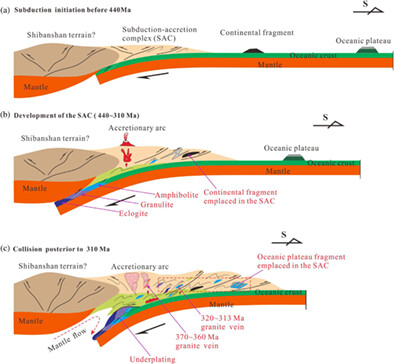
A possible evolutionary model of the Hongliuxia SAC in the southern Dunhuang Orogen. (a) Prior to 440 Ma, the oceanic plate subduction was initiated in the southern Dunhuang region. (b) During 440 ~ 310 Ma, the different kinds of rocks were juxtaposed in the subduction zone. (c) The oceanic basin could be closed after 310 Ma.
Assessment of tectonic activity based on the geomorphic indices in the middle reaches of the upstream of Jinsha River, China
- Pages: 3974-3991
- First Published: 13 April 2021
Microbial carbonate sequence architecture and depositional environments of Member IV of the Late Ediacaran Dengying Formation, Gaoshiti–Moxi area, Sichuan Basin, Southwest China
- Pages: 3992-4015
- First Published: 13 April 2021
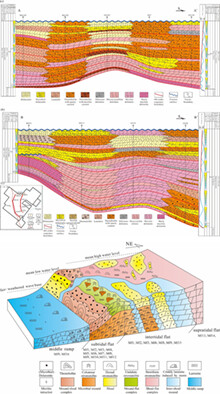
Fourth-order sequence correlation in the Gaoshiti–Moxi area: (a) Sequence correlation of five wells along the platform margin in the Gaoshiti–Moxi area; (b) Sequence correlation of four wells on the platform interior from north to south; (c) Position of wells in the correlation profiles. Depositional model of Member IV of the Dengying Formation in the Gaoshiti–Moxi area.
Fluid inclusions, stable isotopes (H–O–S), and age constraints on the genesis of the Basitielieke polymetallic tungsten deposit in the Altay, Xinjiang, NW China
- Pages: 4016-4037
- First Published: 14 April 2021
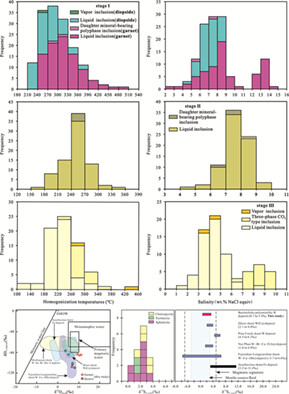
The ore-forming fluid can be divided into H2O–NaCl systems, including stage I and II, and a H2O–CO2 (±CH4/N2)–NaCl system in stage III. Stable isotope compositions indicate that magmatic water participated in the hydrothermal mineralization system in stage I, and meteoric water increased with the process of mineralization. Sulphur was derived from deep-seated magmas.
Jurassic–Lower Cretaceous sequence stratigraphy and allogenic controls in proximal terrestrial environments (Southern Junggar Basin, NW China)
- Pages: 4038-4062
- First Published: 18 April 2021
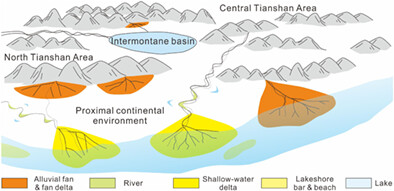
The proximal terrestrial environment and sequence. The proximal terrestrial sequences exhibit rapid sedimentary facies change, thick coarse-grained sediments, and multiple provenances. The dotted lines represent different migrating channels in different stages , which are common in proximal terrestrial environment
Sulphate supergene minerals: An intuitive indicator for deep deposit in plateau regions
- Pages: 4063-4079
- First Published: 19 April 2021
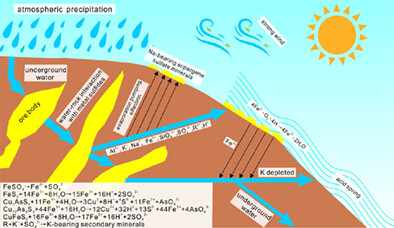
Though the Rongna deposit has not been exploited, supergene minerals are well-grown alongside a highly acidic river (pH ≈ 3) developed on a hillslope of the Rongna deposit, covering about 1.53 km2. The X-ray diffraction and scanning electron microscope results show they consist natrojarosite, hexahydrite, tamarugite, anhydrite, pockeringite, blodite, gypsum and naujakasite, among which, naujakasite is discovered for the first time in China. Supergene minerals and acid water who usually appear around mines and tailings barely exist in plateau regions because the factors like temperature, oxygen content and precipitation are restricted. The material sources of these sulphate minerals and acidic water are from the sulphate in the ores that experience the leaching process and oxidation. And the surface environment charactered by strong evaporation provide a good place for the precipitation of the sulphate supergene minerals from the acidic river. The mineral exploration in plateau regions are usually tough and complex because of disadvantageous terrain and hostile environment, the sulphate supergene minerals whose causes are special and meaningful in plateau regions can be a more economical, visualized and accurate indicator for deposit prospecting.
The Middle Permian (Capitanian) carbonate platform evolution and stratigraphic architecture of a Neo-Tethys rim basin, Central Pakistan
- Pages: 4080-4101
- First Published: 22 April 2021

The detailed sedimentological and stratigraphical investigations of the Middle Permian (Capitanian) succession of Wargal Formation revealed evolution of carbonate platform in three stages. The evolution of platform is linked directly with global events. However, the impact of local events is recorded minimum.
Early Permian back-arc extension in the southeastern Central Asian Orogenic Belt: Evidence from the gabbro–granite complex, Xilinhot, Inner Mongolia, China
- Pages: 4102-4125
- First Published: 26 April 2021
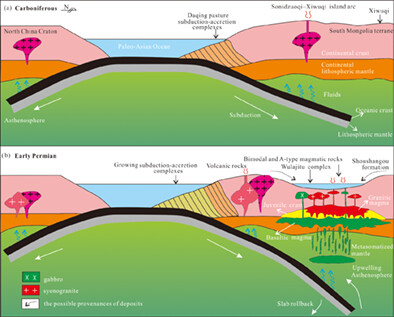
During the Late Palaeozoic, the PAO was continuously double-sided 1 subduction along the Solon–Xar Moron suture belt. It subducted southward beneath the NCC, forming an Andean arc magmatite belt. In contrast, it subducted northward beneath the South Mongolian terrane, resulting in a series of arc magmatic rocks and subduction–accretion complexes. In the Early Permian, the rollback of subducted PAO plates led to asthenospheric mantle upwelling and an extension of the overlying lithosphere, resulting in a back-arc extensional setting in the Xilinhot–Xiwuqi linear zone. Decompression melting of upwelling asthenospheric mantle triggered interactions between asthenosphere derived magma and the overlying lithosphere mantle, generating basaltic magma with depleted mantle characteristics. Furthermore, the fluid formed by the dehydration of the subducting plates further promoted this melting process, also depleting the HFSEs of basaltic (gabbroic) magma (such as Nb and Ta). The upwelling asthenosphere and basaltic underplating provide sufficient energy for the partial melting of lower juvenile crust, thus producing granitic magma. Gabbroic and granitic magma experienced different degree of evolution in the rising and emplacement process, ultimately resulting in bimodal (A-type) magmatic rock associations in the region, as the representative of the Wulajitu gabbro–granite complex.
Geochronological, geochemical, and Sr–Nd–Pb–Hf isotopes of Cretaceous gneissic granite and quartz monzonite in the Tongbai Complex: Record of lower crust thickening beneath the Tongbai orogen
- Pages: 4126-4149
- First Published: 26 April 2021
Quaternary corals (Scleractinia: Merulinidae) from the Egyptian and Saudi Arabian Red Sea Coast
- Pages: 4150-4188
- First Published: 26 April 2021
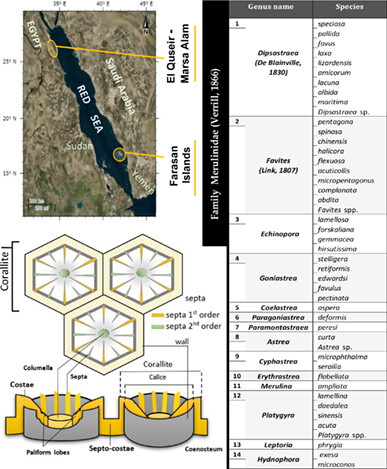
The coral species of family Merulinidae in the Egyptian and Saudi Arabian Red sea coast are described and illustrated at species level based on skeletal structure for helping in evaluating and estimation of actual species diversity as well as predicting their response to environmental changes. 37 species are recorded for the first time from the Farasan Islands and 26 species from El Quseir-Marsa Alam area, among them three species are recognized as new records. Two species are added to coral communities of the Red Sea (Goniastrea favulus and Paragoniastrea deformis), and six species were added to the fossil record of the Red Sea. Most species still living in the present Red Sea except 3 (F. micropentagonus, G. favulus and P. deformis) and all species are extended down to the Pleistocene and few to Pliocene and Miocene
Study on the detrital zircon fission-track ages from natural borehole samples in the Bohai Bay and Tarim basins with different thermal backgrounds
- Pages: 4189-4200
- First Published: 26 April 2021
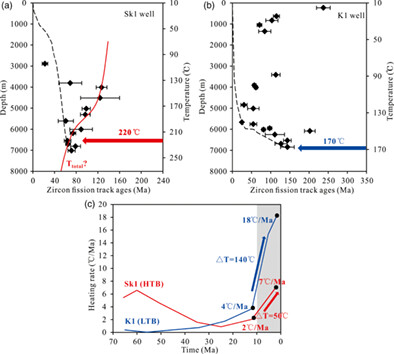
- The annealing temperature of the zircon fission track was about 220°C in the Bohai Bay Basin with a high thermal background, and 170°C in the Tarim Basin with a low thermal background.
- ZFT annealing temperature at a high thermal background is higher than at a low thermal background.
- Zircon fission track from different thermal settings have different annealing temperatures and annealing behaviour due to the different heating rates.
Microfacies and stable isotope features of the Lower–Middle Jurassic carbonate rocks of Western Saharan Atlas (Aïn Ouarka area, Algeria)
- Pages: 4201-4216
- First Published: 27 April 2021

The depositional environment of Jurassic Lower Carbonate Group in the Aïn Ouarka area of Western Saharan Atlas, Algeria includes six microfacies types (MF1 to MF6) regrouped in three facies association (FA1 to FA3), this latter is developed in homoclinal carbonate ramp (inner-ramp,mid-ramp and outer-ramp) and developed during a transgressive–regressive cycle.
Migmatite rheology of crustal catazone: An example from the SSE part of T. Sundupalle granite-greenstone terrain, Eastern Dharwar Craton, India
- Pages: 4217-4245
- First Published: 27 April 2021

- Migmatites from East Dharwar Craton is classified for the first time with proper genetic model
- Structure and metamorphism are correlated with tectonics and genetic link among different types of migmatite are established with schematic model
- Significance of migmatites are explained in the formation of granite with respect to crustal reworking
- Crustal evolution of East Dharwar Craton vis-à-vis schist-gneiss-migmatite is explained with reference to global frame.
Quaternary lacustrine dolostones of Sahara: New geoheritage evidence from the Farafra Oasis (Egypt)
- Pages: 4246-4253
- First Published: 05 May 2021
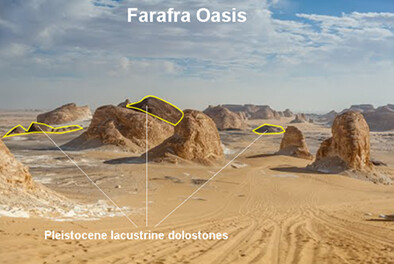
Pleistocene lacustrine dolostones are found in the northeastern part of the Farafra Oasis. They are formed as a result of carbonate deposition in a palaeolake and incised channels, with post-depositional replacement of calcite by dolomite. The uniqueness of these features allows their assignment to the sedimentary, palaeogeographical, and stratigraphical types of geoheritage, which is best represented at the North Ain El-Wadi locality proposed as a geosite.
Facies architecture and depositional model for a fine-grained hybrid-energy delta: An example from the Upper Cambrian to Lower Ordovician Barik Formation, Central Oman
- Pages: 4254-4279
- First Published: 13 May 2021
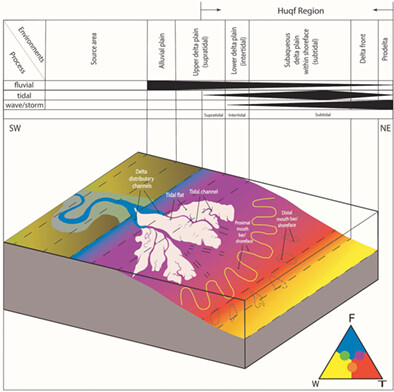
Cambrian-Ordovician fine-grained hybrid-energy delta of Barik Formation, outcropped in Central Oman, has been studied in details to determine fluvial, wave and tidal signatures and to identify depositional environments. Depositional model was reconstructed based on four depositional environments, such as mouth bar/shoreface, tidal flat, tidal channel, delta distributary channels.
The characteristics of Carboniferous volcanic lithofacies and volcanic reservoirs of Ke-Bai Fault Belt, northwestern Junggar Basin
- Pages: 4280-4292
- First Published: 14 May 2021
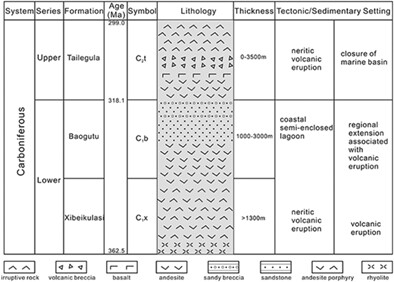
The significant hydrocarbon reserves resulted from volcanic reservoirs in the cCarboniferous have been discovered in last few decades in Ke-Bai Fault Belt, northwestern Junggar Basin. Lot of studies have been conducted to identify volcanic lithology and describe reservoir characteristics. However, few of them have been focused on the description and interpretation of volcanic facies and volcanic reservoirs as well as their responses to controlling factors. In this study, the integrated analysis of wireline logs, image logs, core photographs, thin sections, and scanning electron microscope allows the description and interpretation of volcanic facies and volcanic reservoirs as well as their responses to controlling factors. The results indicate that several types of lithology are identified based on cores, including volcanic rocks, followed by sedimentary rocks and metamorphic rocks. In addition, explosive facies, effusive facies, volcanic sedimentary facies, and sub-volcanic facies are delineated according to spatial distribution, occurrence condition and appearance characteristics of volcanic products. Furthermore, the reservoir space (including pores and fractures) is analysed and characterized. Finally, the controls on volcanic reservoirs are revealed, including volcanic lithofacies, tectonic movements, and diagenesis.
Palaeoflood events during the last deglaciation in the Yellow River source area on the northeast Tibetan Plateau
- Pages: 4293-4309
- First Published: 20 May 2021
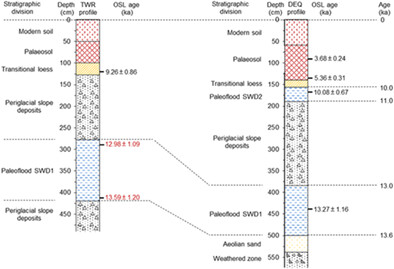
Two episodes of prehistoric overbank flooding were OSL dated to 13.6–13.0 ka BP and 11.0–10.0 ka in the Yellow River source area on the NE Tibetan Plateau. These overbank flooding may have resulted from accelerated melting of mountain glaciers and snow over the headwaters of alpine and subalpine regions.
Detrital zircon LA–ICP–MS U–Pb ages for sedimentary rocks from the Kuhai–Saishitang area, NE Tibet: Constraints on provenance and Cu exploration
- Pages: 4310-4330
- First Published: 22 May 2021
Alkaline magmatism on Neo-Tethyan extensional domains: Evidences from the Gejiu complex in Yunnan, China
- Pages: 4331-4348
- First Published: 27 May 2021
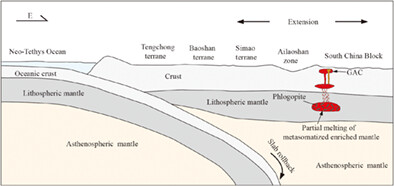
It is interesting that alkaline magmatism, consisting of syenites and feldspathoid syenites, took place at about 85 Ma by <10% partial melting of the lherzolite in enriched mantle source at depth of 60–80 km below the surface with condition about 810–956°C and 1.8–2.4 Gpa under an extensional tectonic setting.
Sulphide geochemistry of the superlarge Tiegelongnan Cu (Au) deposit in Tibet, China: Implication for the mineralization process
- Pages: 4349-4365
- First Published: 30 May 2021
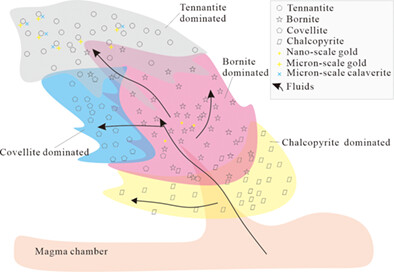
Though detailed optical microscope observation, we classified the typical sulphide–gangue mineral assemblage end members produced in the major ore-bearing alteration zones. By contrasting with these end members, we recognized the spatial distribution of other sulphide–gangue mineral assemblages in various transition zones. Specially, a large proportion of covellite–sericite–kaolinite (±APS) assemblage was found to be produced on one side of the ore-body centre in the study. We find the acid fluids, which induced by hydrolysis of CO2 and SO2, notably contributed to the mineralization process. We make a knowledge of the enrichment tendency of Au and Ag in ore-forming process based on the analyses of the distribution of trace element and trace minerals in the copper sulphides by LA–ICPMS and SEM-EDS.
Textures and trace element geochemistry of magnetite in the Beiya gold deposit, SW China
- Pages: 4366-4379
- First Published: 31 May 2021

- Euhedral–subhedral (ME), anhedral (MA), lamellar (ML), and post-ore fluids replaced (MR) magnetites have been identified at Beiya;
- Post-ore fluids replacement and dissolution–reprecipitation process could modify both texture and chemical composition of the primary magnetite;
- The decreasing V content combined with haematite after magnetite suggests that the oxygen fugacity increased from ME to MA and then decreased; and
- Textures combined with trace element variations of magnetite could record hydrothermal fluid evolution.
Genesis and fluid evolution of the Yuku porphyry Mo deposit, East Qinling orogen, China
- Pages: 4380-4400
- First Published: 03 June 2021
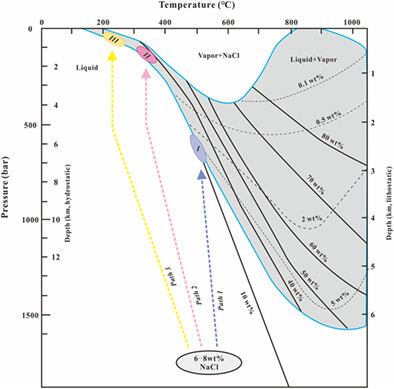
Fluid evolution paths of the Yuku Mo deposit. The initial fluids exsolved from deep magma chamber are assumed supercritical magmatic fluids with an initial salinity of 6–8 wt% NaCl equiv. These fluids followed three different cooling paths: (a) path 1 shows the fluid trajectory forming quartz–K-feldspar–biotite vein (488–550°C, 550–700 bar, and 2.3–2.8 km under a lithostatic condition); (b) path 2 shows the trajectory forming Mo-dominated mineralization (309–361°C, 100–200 bar, and 1.0–2.0 km under a hydrostatic depth); (c) path 3 shows the trajectory forming quartz–polymetallic sulfide stage of mineralization (198–298°C, <100–150 bar, and <1.0 km under a hydrostatic depth).
Geochemistry and geochronology of intermediate volcanic rocks from the Compostela area, Nayarit, Mexico: Implications for petrogenesis and tectonic setting
- Pages: 4401-4428
- First Published: 14 June 2021
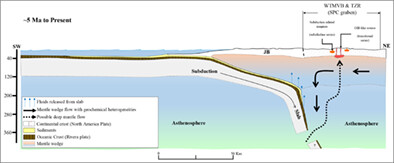
Graphical abstract presents a diagrammatic illustration of the subduction zone of the Rivera plate is mostly below the Jalisco Block outward of the western sector of TMVB. This observation supports the argument that the young and small Rivera plate has torn and the remaining shallow steepening slab is rolling back trenchward, and that between the Rivera and Cocos slabs exists a gap that increases in size at depth and the Rivera plate subducts more steeply than the Cocos plate. This gap allows magma from the deep mantle (asthenosphere), below the subducted Rivera slab, to rise through the mantle wedge resulting in OIB-like basalts (transitional series). Over the remaining shallow slab, subduction related magmas with andesitic composition (sub-alkaline series) develop.




